The tragic decline of the large mammals of the Indonesian archipelago, the orangutans, the rhinos, tigers and elephants, has been well documented. Not so well known is the loss of the smaller animals like the frogs and lizards. Other than general reports of sharp declines in frog populations across the globe, I haven’t seen any recent scientific counts of these animals in Indonesia, but my general impression was that all these small animals were noticeably less numerous than on my previous visits to Indonesia. I have memories of dozens of lizards scurrying up and down the walls around any light in the evening, and evening frog-choirs around any small pond or rice paddy.
These days, the evenings were largely silent, except right out in the jungle, where after a rainstorm the evenings came alive with frog sounds just as before. Their decline in the more populated areas, and the farmed areas, is no doubt related to the more intensive farming methods, and the greater use of pesticides. Frogs, with their permeable skin, are very sensitive to pesticides.
The arthropod life was still phenomenal – we saw an extraordinary variety of butterflies and colourful beetles, giant centipedes, and some comical little sand crabs. These crabs had eyes that popped up vertically when they came out onto the sand and there was something to see, then folded back against their bodies, out of the way, when the crab was burrowing in the sand.
In the forest we saw a hive of wild bees, mostly below ground but with a beeswax entrance, and if you like cockroaches, you can’t go past the bat caves at Gomantong, where they feast on the mountainous piles of bat and swiftlet guano. There were lots of other really creepy-looking bugs in the bat caves, but it was too dark to photograph them properly.
Everyone’s prize for the most disgusting small animal goes to the leeches, of which there were plenty. I had heard that you don’t feel a thing when they start to feed, but fortunately, I always did – a sharp itchy pain not unlike a mosquito bite. If you wrench them off quickly they can’t do much harm, but the danger is that they will get you when you are sleeping. I found several hiding on my boots, curled up into a tiny, almost invisible blob, waiting to attack under cover of darkness.
One morning in Kinabatangan I awoke to find a large one marching towards me across the bed. I jumped up and grabbed it, wrapped it in a tissue so that it couldn’t attach itself to me as I wrestled with it, and tried to kill it with my thumbnail. But they’re tough. They might look like soft little pink worms, but this one was harder to kill than Rasputin. I kept opening up the tissue expecting to see it in two halves, but it was still whole, and fighting back.
The stars of the small fauna were the mudskippers, of which we saw several different species in the mangrove swamps.
These intriguing little fish that get up out of the water and walk along on their pectoral fins, obtain their oxygen partly through a permeable skin, like frogs. Perhaps because of their marine habitat, the permeable skin doesn’t seem to have made them as vulnerable as frogs to agricultural chemicals; they still seemed to be very numerous. Some that we saw had elaborate skin flaps around the eyes, the function of which is unknown to me.

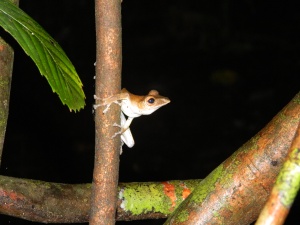
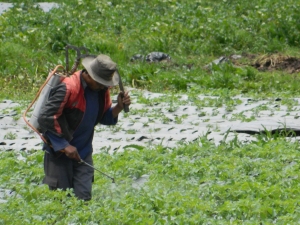
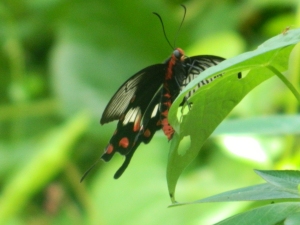
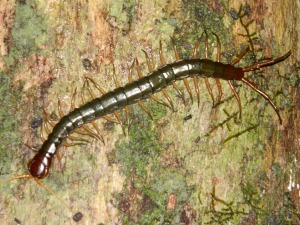
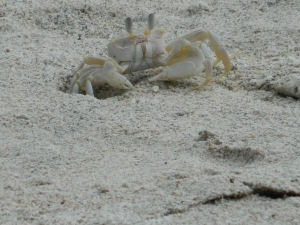

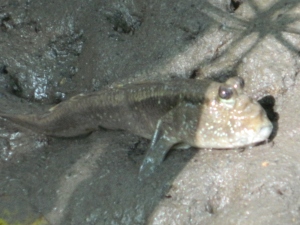
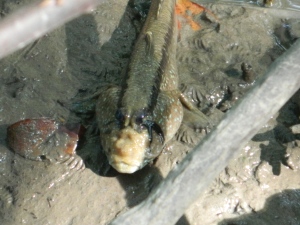
Good day! I’m currently conducted a research regarding an intertidal organisms, mudskipper in Borneo. Supposedly I should collect conservative status of this unique fish over the Sabah, however, due to some limitation I was unable to do so in recent time. So if you don’t minded, could you share with me some of your experiences regarding to this fish? I am very concerned about the relationship of the fish related to its surrounding habitat.
Thank you.
Regards,
Jean
Hi Jean,
Thanks for your note. Unfortunately, I have little to share beyond what appears in this post. The mudskippers seemed very numerous in all the muddy places – especially the mangrove swamps, but also any other estuarine inter-tidal zones where mud settled, including places where there was a lot of human activity, such as around ferry wharves. We saw them around the island of Borneo (both Sabah and Kalimantan), but they are more widely distributed than that I think. There appeared to be several different sizes and species.
Thanks for your sharing! During my first visit to Kota Kinabalu, Sabah, I am surprised too that quite a number of individual scatter around intertidal zone where currently undergo construction project. They just lived inside tidal pools full of polluted waste water and oil. But because of their trophic level in food web, some predators might accumulated toxic by consuming them. However, I haven’t sighted a well-mixed community in a single habitat…
If it is possible, can I have your permission to use some of your pictures for ID and description purposes?
Sincerely,
Jean
Pingback: Do women exist? – the science of sex, the politics of gender, and the materialist and dialectical thinking needed to distinguish the two | A communist at large·